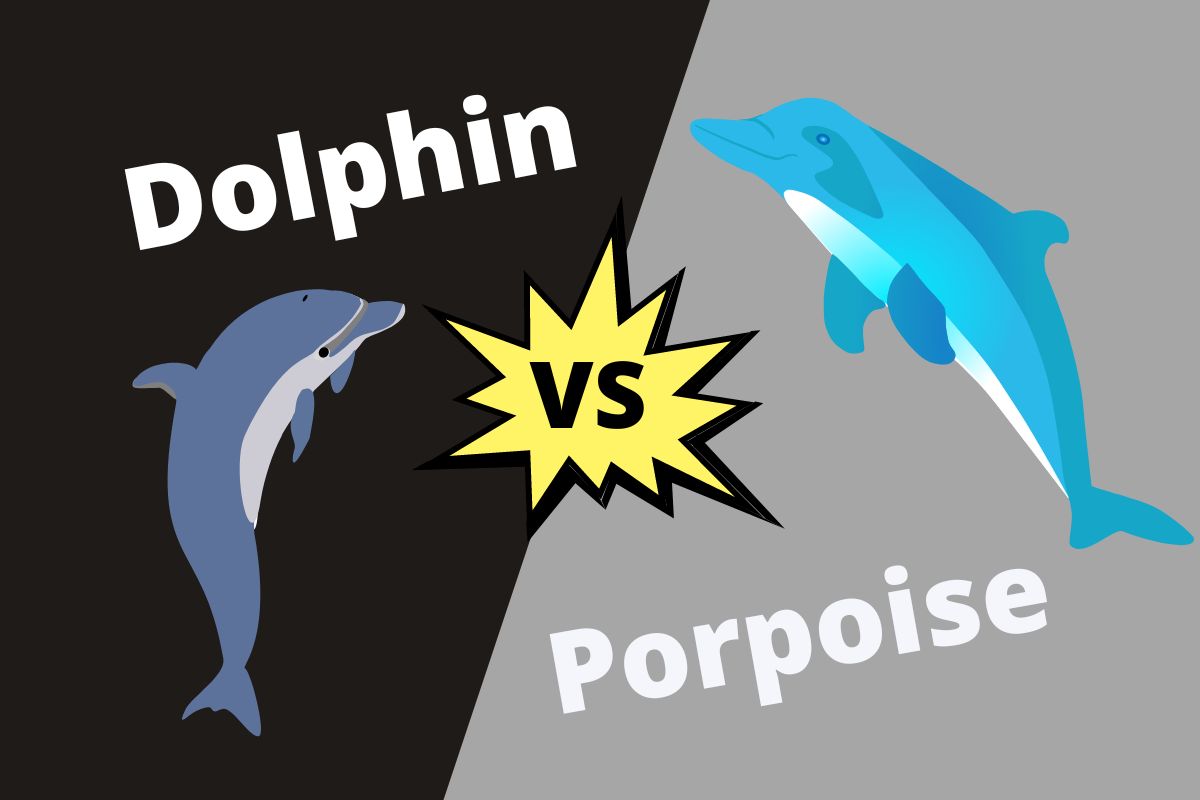The main difference between dolphin and porpoise is that dolphins have elongated beaks and cone-shaped teeth, while porpoises tend to have blunt beaks and spade-shaped teeth.
Dolphins and porpoises are two fantastic sea creatures in the toothed whale suborder. But they are often mistaken for each other.
However, there are a lot of differences between the two.
Let’s explore some differences between dolphin and porpoise, their diet, and more.
Table of Contents
What is a Dolphin?
Dolphins are marine animals that dwell in almost all oceans. Humans find a close relationship with them because of many similarities. For instance, dolphins are mammals, give birth to a single baby, and even have belly buttons.
Dolphins belong to the small-toothed cetacea, an order of marine animals that comprises whales.
Though dolphins inhabit a wide variety of habitats, only a few species, like river dolphins, reside in freshwater.
Physical Features
Since dolphins don’t have gills, they get oxygen from eating freshwater fish. Their nostrils are on top of their head, and thus, they come to the surface to take oxygen.
Dolphins have complex brains. In addition to their intelligence and curiosity about humans, dolphins are known for their acrobatic abilities and friendly nature.
Another attractive feature of dolphins is their curved beaks, which appear like a permanent smile. Smaller dolphins have an average lifespan of 20 years, while larger ones live for around 80 years.
Diet of a Dolphin
Dolphins evolved from land mammals. However, they have developed numerous adaptations that make them suitable to live in water. They are carnivorous predators and use their strong teeth to hold their prey. Dolphins consume fish, squid, crustaceans, shrimp, and octopus.
A few species of dolphins work in groups to herd. They use echolocation.
Echolocation, also called biosonar, uses sound waves to help find the location of objects. It sounds like clicks, whistles, and squeals, to sense their surroundings, hunt for prey, and find their peers.
Most dolphins are light-eaters, unlike porpoises.

What is a Porpoise?
Porpoises are fully aquatic mammals classified under the family Phocoenidae and order Cetacean. They are found in rivers, coastal water, shelf water, and the ocean. These marine animals have streamlined bodies and are equally intellectual as dolphins.
However, porpoises are more closely related to narwhals and belugas. Porpoises produce ultrasonic clicks for navigation and social communication. Unlike dolphins, they do not form large social groups. They are intelligent, self-aware, and shy.
Diet of a Porpoise
Porpoises are heavy eaters, and some finless porpoises follow seasonal migration. Though they feed various creatures, fish and squid are every porpoise’s favorite.
FYI: The benthic (or groundfish) and pelagic fish are the two most common ones porpoises are fond of.

Dolphin vs Porpoise
| Dolphin | vs | Porpoise |
| White, pink, brown, gray, blue, and black | Color | Black, dark gray, light gray, and white |
| An elongated beak that extends from the face | Nose | A blunt beak that blends with the rest of their face |
| Tropical or temperate water | Ideal Habitat | Cold marine water |
| 1 meter to 6 meters | Size | 1.5 meters to 2.5 meters |
| Dolphins are social animals and are more curious about humans. | Social Behavior | Porpoises are known for their shy nature |
| Curved dorsal fin | Dorsal Fin Structure | Triangular dorsal fin |
| Fish, squid, marine mammals | Common Diet | Usually, fish and squid |
| 42 species | Number Of Species | 7 species |
Apart from belonging to the same order cetacean, there are some significant differences between the two. Let’s understand them below.
Family
Dolphins belong to the Delphinidae family, which includes moderate to small-sized toothed whales, including dolphins, pilot whales, and killer whales. Porpoises, however, are in the Phocoenidae family. Porpoises, while technically dolphins, are more closely related to narwhals and belugas.
Color
Dolphins are primarily found in white, pink, brown, grey, blue, and black colors. Porpoises are generally black, dark grey, light grey, and white.
Nose
Dolphins have an elongated beak that extends from the face. On the other hand, porpoises have a blunt beak that blends with the rest of their face.
Ideal Habitat
Dolphins mostly live in tropical or temperate water. However, few species of dolphins live in freshwater, and porpoises live in cold marine water.
Size
The size of dolphins ranges from 1-6 meters. Porpoises are stouter than dolphins and range between 1.5 – 2.5 meters.
The orca (or the killer whale) is the largest toothed dolphin.
Social Behavior
Dolphins are social animals and are more curious about humans; however, porpoises are relatively shy.
Dorsal Fin Structure
Dolphins have a curved dorsal fin, while porpoises’ dorsal fin is triangular and somewhat like sharks.
Common Diet
Dolphins consume a wide variety of fish, squid, and marine mammals, while porpoises stick to fish and squid for consumption.
Number Of Species
There are currently 42 species of dolphins, while only seven species of porpoises are known.
Know the Difference Between Dolphin and Porpoise
Oceanic dolphins and porpoises are marine animals in the same order, Cetacea, but in different families. They have various structural and behavioral differences.
If you ever come across a streamlined, large cetacean with a defined beak and a hooked dorsal fin, then undoubtedly, it’s a dolphin.
On the other hand, if you find a smaller, chunky animal with a round face and triangular dorsal fin, it’s a porpoise.

